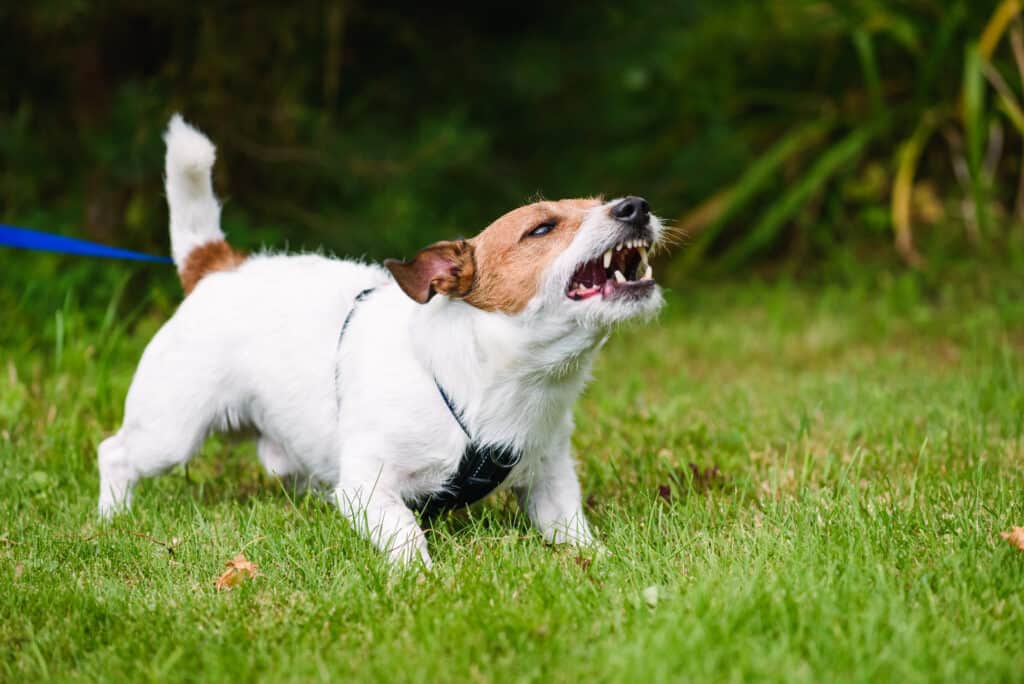A dog and their handler are out for a casual weekend stroll. The dog is at the end of its leash, barking and snarling threateningly at people, dogs or vehicles which pass by. They have clearly crossed the threshold where reasoning occurs, and if there was a dictionary referencing symptoms of arousal in dogs, this one would be demonstrating the entire vocabulary. The pair return home and the handler’s spouse asks how the walk went. The handler replies, “Oh, you know, a bit stressful as usual… Fido is just always trying to protect me from everything!”
This visual is not an uncommon occurrence, but oftentimes the intention behind the behavior is misinterpreted. Yes – dogs can and do resource guard their humans; however, the behavior of “guarding” humans or property often looks much different than the behaviors which these dogs are displaying.
So, if a dog is unlikely to be protecting you while they are demonstrating these threatening behaviors, what is actually going on?
The thing about arousal…
You have likely heard the term “arousal” referenced loosely in dog training communities before, and in these contexts it can mean a number of different things. In this article, we will be defining arousal as, “physiological preparedness to perceive and react to environmental stimuli through the activation of the sympathetic nervous system.” In other words, arousal in this context can be considered a stress response. Whether interaction with a stimulus is desirable or not, the resulting physiological process is virtually identical.
When a triggering stimulus causes up-regulation of the sympathetic nervous system (SNS), epinephrine and norepinephrine (adrenaline and noradrenaline) are released, the HPA (hypothalamic-pituitary-adrenal) axis is activated and a cascade of physiological responses occur. When this happens, a dog will typically respond with elevated reactivity or behaviors relative to the flight, fight or freeze response. Arousal can initiate many behaviors which you will not see when your dog is relaxed. From very intense focus to seemingly scattered attention, or excessive activity to freezing behaviors, elevated arousal levels can result in dogs acting in ways that they would not otherwise.
The thing about arousal is that the associated physiological symptoms, such as increased heart rate, increased blood pressure and increased respiration, mimic the same changes induced by stress. Recent research such as this study conducted on shelter dogs has further supported that arousal is a response to stress.

So why does my dog act like that?
You might be wondering what all of that nervous system gibberish has to do with your dog’s reaction towards the things which they appear to be valiantly defending you from. So here it is: stress is often caused by a perceived threat to an animal’s wellbeing, and this feeling is typically a response to fear. When an animal feels threatened and unable to escape (such as occurs when a dog’s movement is restricted by a leash) they are much more likely to resort to fighting type behaviors. The threatening vocalizations and lunging at the end of your lead could very well be your dog’s way of simply trying to fight itself out of a situation that it deems threatening.
Some examples of dogs most likely to display this sort of reactivity are:
- Dogs with previous social trauma
- Naturally timid dogs
- Dogs with pain or health issues
- Unsocialized or minimally socialized dogs
- Dogs who spent a lot of time in a stressful environment
- Dogs who were forced to interact at a point in their life when they did not feel comfortable doing so
- Dogs with higher SNS activity (often due to chronic acute stress)
- Dogs with neurotransmitter or hormonal imbalances
- Dogs spending a lot of time behind barriers (such as fences)
Implementing an effective socialization protocol alongside resiliency training and leash work can do wonders for improving these behaviors and making your dog feel more confident around triggers.
In some instances, exuberant dogs with underdeveloped impulse control display behaviors which appear threatening even when they are not. In these instances, the inability to interact directly with a stimulus creates frustration which can trigger a physiological stress response.
Some examples of dogs most likely to display this sort of reactivity are:
- Young dogs (including adolescents)
- Minimally socialized dogs
- Naturally vocal dogs
- Dogs who were allowed to interact when these behaviors were displayed
- Dogs who who have “big feelings” about other things in their life
- Easily frustrated dogs
- Dogs spending a lot of time behind barriers such as fences
In situations where excitement induced frustration is likely the culprit for these behaviors, working on developing impulse control, coping mechanisms for frustration, implementing effective socialization strategies and ensuring that your dog is getting adequate physical and cognitive enrichment can make a significant positive impact on reactive behaviors.
Barrier frustration can also cause a generalized, intense reaction to certain stimuli while on lead. Dogs who spend time unsupervised behind fences, especially the ones who regularly chase dogs, people or vehicles along the fence barking, can display these same responses when on lead, behind a window or in a car. If you believe that barrier frustration may be causing your dog’s leash reactivity, it is imperative to ensure that they are not able to practice the behavior at all while you are working through a treatment plan. Barrier frustration can re-wire a dog’s brain over time and is often very rewarding for the dog. Because of this, barrier frustration related behavioral protocols are very systematic and require a certain duration of time where triggering situations are eliminated from the dog’s life.
In conclusion
It can be difficult to hear that a dog’s reactive behavior is – in most cases – unlikely to be caused by a valorous effort to protect their handler. This being said, it is critical to understand the cause of any behaviors which can be dangerous or detrimental to a dog or the people and animals around it.
Knowledge is power, and once we can get over the fact that our dog’s reactive behavior is likely motivated by causes outside of us, we can take the steps necessary to help. Taking the time to consider the cause of reactivity will not only enable us to improve our dog’s life, but it could make a significant positive impact on our own life as well.

